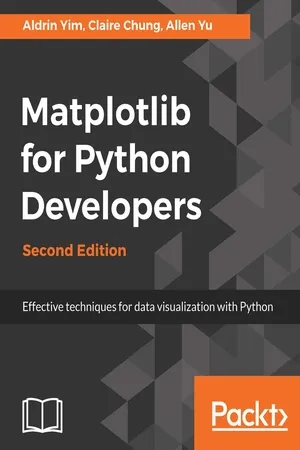
- 300 pages
- English
- ePUB (mobile friendly)
- Available on iOS & Android
Matplotlib for Python Developers
About this book
Leverage the power of Matplotlib to visualize and understand your data more effectivelyAbout This Book• Perform effective data visualization with Matplotlib and get actionable insights from your data• Design attractive graphs, charts, and 2D plots, and deploy them to the web• Get the most out of Matplotlib in this practical guide with updated code and examplesWho This Book Is ForThis book is essentially for anyone who wants to create intuitive data visualizations using the Matplotlib library. If you're a data scientist or analyst and wish to create attractive visualizations using Python, you'll find this book useful. Some knowledge of Python programming is all you need to get started.What You Will Learn• Create 2D and 3D static plots such as bar charts, heat maps, and scatter plots• Get acquainted with GTK+3, Qt5, and wxWidgets to understand the UI backend of Matplotlib• Develop advanced static plots with third-party packages such as Pandas, GeoPandas, and Seaborn• Create interactive plots with real-time updates• Develop web-based, Matplotlib-powered graph visualizations with third-party packages such as Django• Write data visualization code that is readily expandable on the cloud platformIn DetailPython is a general-purpose programming language increasingly being used for data analysis and visualization. Matplotlib is a popular data visualization package in Python used to design effective plots and graphs. This is a practical, hands-on resource to help you visualize data with Python using the Matplotlib library.Matplotlib for Python Developers, Second Edition shows you how to create attractive graphs, charts, and plots using Matplotlib. You will also get a quick introduction to third-party packages, Seaborn, Pandas, Basemap, and Geopandas, and learn how to use them with Matplotlib. After that, you'll embed and customize your plots in third-party tools such as GTK+3, Qt 5, and wxWidgets. You'll also be able to tweak the look and feel of your visualization with the help of practical examples provided in this book. Further on, you'll explore Matplotlib 2.1.x on the web, from a cloud-based platform using third-party packages such as Django. Finally, you will integrate interactive, real-time visualization techniques into your current workflow with the help of practical real-world examples.By the end of this book, you'll be thoroughly comfortable with using the popular Python data visualization library Matplotlib 2.1.x and leveraging its power to build attractive, insightful, and powerful visualizations.Style and approachStep by step approach to learning the best of Matplotlib 2.1.x
Frequently asked questions
- Essential is ideal for learners and professionals who enjoy exploring a wide range of subjects. Access the Essential Library with 800,000+ trusted titles and best-sellers across business, personal growth, and the humanities. Includes unlimited reading time and Standard Read Aloud voice.
- Complete: Perfect for advanced learners and researchers needing full, unrestricted access. Unlock 1.4M+ books across hundreds of subjects, including academic and specialized titles. The Complete Plan also includes advanced features like Premium Read Aloud and Research Assistant.
Please note we cannot support devices running on iOS 13 and Android 7 or earlier. Learn more about using the app.
Information
Embedding Matplotlib in GTK+3
Installing and setting up GTK+3
#Installing the gtk3 package brew install gtk3 #Installing PyGObject brew install pygobject3
A brief introduction to GTK+3
Table of contents
- Title Page
- Copyright and Credits
- Dedication
- Packt Upsell
- Contributors
- Preface
- Introduction to Matplotlib
- Getting Started with Matplotlib
- Decorating Graphs with Plot Styles and Types
- Advanced Matplotlib
- Embedding Matplotlib in GTK+3
- Embedding Matplotlib in Qt 5
- Embedding Matplotlib in wxWidgets Using wxPython
- Integrating Matplotlib with Web Applications
- Matplotlib in the Real World
- Integrating Data Visualization into the Workflow